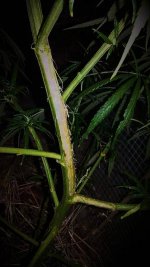-
ICMag with help from Phlizon, Landrace Warden and The Vault is running a NEW contest for Christmas! You can check it here. Prizes are: full spectrum led light, seeds & forum premium access. Come join in!
You are using an out of date browser. It may not display this or other websites correctly.
You should upgrade or use an alternative browser.
You should upgrade or use an alternative browser.
Looking for guerillas with leaf spot diease experience.
- Thread starter hamstring
- Start date
Yes the bacterial leaf spot has led me here as well. Hamstring you dont know be as this is my 1st post here but I want to thank you for this journal. I was banging my head against a wall for two years with this problem and still have not figured it out.. Past 2-3 years have been by far the worst in fact I dont remember having this problem ever prior to 2010. This season is looking about the same !
SwampCracker
I just looked at the time I started this thread 2010 and it seems like that was the first year I had leaf spot damage my crop also. Not saying it hasn’t been there all along but before 2010 it never hit hard enough for me to notice.
I get it every year now depending on how wet or dry the season usually calls out how bad I get it. I was caught off guard this year because usually you start seeing the signs 2nd week of July. This year all looked well until last two weeks of August I got hit pretty hard.
I know liquid cooper works well when applied on a regular basis but it all depends on how often it rains. The very nature of beast says you wouldn’t be dealing with a severe case of leaf spot if it weren’t raining a lot.
I'm a guerrilla grower and it’s not part of my MO to spray every week. If you follow the thread all the way through there are some mention of systematics you can spray on it but I personally have never tried them. Systematics stay with the plant internally if you will and will not wash off. There are many pros and cons to systematics but as mentioned I have no experience with them.
I’m really thinking of some preventative maintenance next season with some beneficial soil additives but have no real world experience to see if they actually help in a guerilla environment. If it boils down to foliar sprays organic or not it doesn’t fit the guerilla growers MO to be tending illegal crops on a weekly basis.
I have been around for a while not because of my growing prowess but because of my security measures. I can’t trade one for the other.
Swampcracker
New member
Yes I have read over the thread 2 times and currently spraying Copper fungicide all over the plants.. At this point as you know it only slows down the inevitable.. I really just wanted to come in here to keep the thread active in the hopes someone comes up with a better solution.. This stuff is no joke and I'm surprised there is not more OD growers in the same boat.. At least in my region. Maybe there are !SwampCracker
I just looked at the time I started this thread 2010 and it seems like that was the first year I had leaf spot damage my crop also. Not saying it hasn’t been there all along but before 2010 it never hit hard enough for me to notice.
I get it every year now depending on how wet or dry the season usually calls out how bad I get it. I was caught off guard this year because usually you start seeing the signs 2nd week of July. This year all looked well until last two weeks of August I got hit pretty hard.
I know liquid cooper works well when applied on a regular basis but it all depends on how often it rains. The very nature of beast says you wouldn’t be dealing with a severe case of leaf spot if it weren’t raining a lot.
I'm a guerrilla grower and it’s not part of my MO to spray every week. If you follow the thread all the way through there are some mention of systematics you can spray on it but I personally have never tried them. Systematics stay with the plant internally if you will and will not wash off. There are many pros and cons to systematics but as mentioned I have no experience with them.
I’m really thinking of some preventative maintenance next season with some beneficial soil additives but have no real world experience to see if they actually help in a guerilla environment. If it boils down to foliar sprays organic or not it doesn’t fit the guerilla growers MO to be tending illegal crops on a weekly basis.
I have been around for a while not because of my growing prowess but because of my security measures. I can’t trade one for the other.
Kygiacomo!!!
AppAlachiAn OutLaW
i to have the leaf spot shit on my some my plants..im gonna order some actinovate,sns244c and neem oil and try that..another guy on farmer said sierra natural science 244 works great to..i know i cant cure it but i want to be able to control it and also the grey mold......the worst plant that got this shit this year is DNA holy grail kush..i have had nothing but pain in the ass with this strain since day 1 and i will never grow it again..sticking to dinafem,paradise, & greenhouseSwampCracker
I just looked at the time I started this thread 2010 and it seems like that was the first year I had leaf spot damage my crop also. Not saying it hasn’t been there all along but before 2010 it never hit hard enough for me to notice.
I get it every year now depending on how wet or dry the season usually calls out how bad I get it. I was caught off guard this year because usually you start seeing the signs 2nd week of July. This year all looked well until last two weeks of August I got hit pretty hard.
I know liquid cooper works well when applied on a regular basis but it all depends on how often it rains. The very nature of beast says you wouldn’t be dealing with a severe case of leaf spot if it weren’t raining a lot.
I'm a guerrilla grower and it’s not part of my MO to spray every week. If you follow the thread all the way through there are some mention of systematics you can spray on it but I personally have never tried them. Systematics stay with the plant internally if you will and will not wash off. There are many pros and cons to systematics but as mentioned I have no experience with them.
I’m really thinking of some preventative maintenance next season with some beneficial soil additives but have no real world experience to see if they actually help in a guerilla environment. If it boils down to foliar sprays organic or not it doesn’t fit the guerilla growers MO to be tending illegal crops on a weekly basis.
I have been around for a while not because of my growing prowess but because of my security measures. I can’t trade one for the other.
Last edited:
I am a guerilla grower and when I was out at my plants a few days ago, I noticed some spots on the leaves. I did not know about leaf spot disease until i read up on it after i got home.
I pulled some leaves off and I took some photos of a few spots on the leaves. What do you all thing this is? Anything to be concerned about?
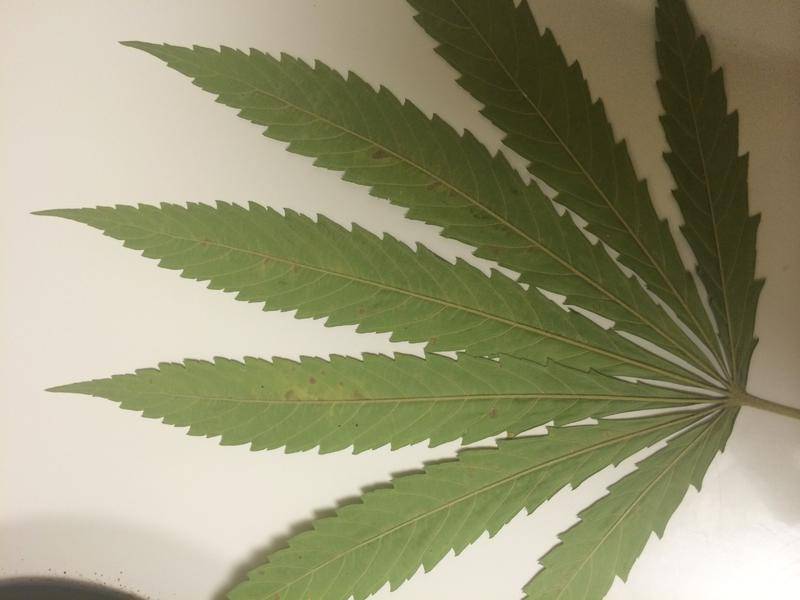

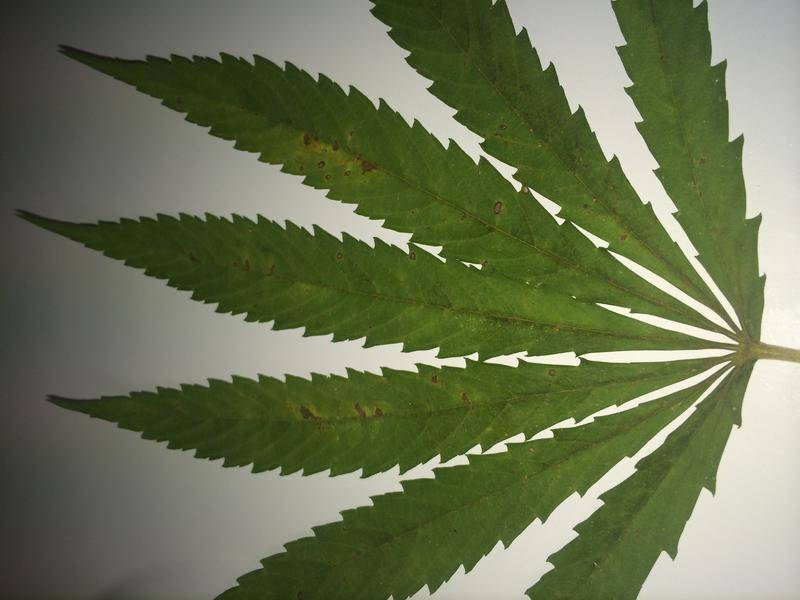
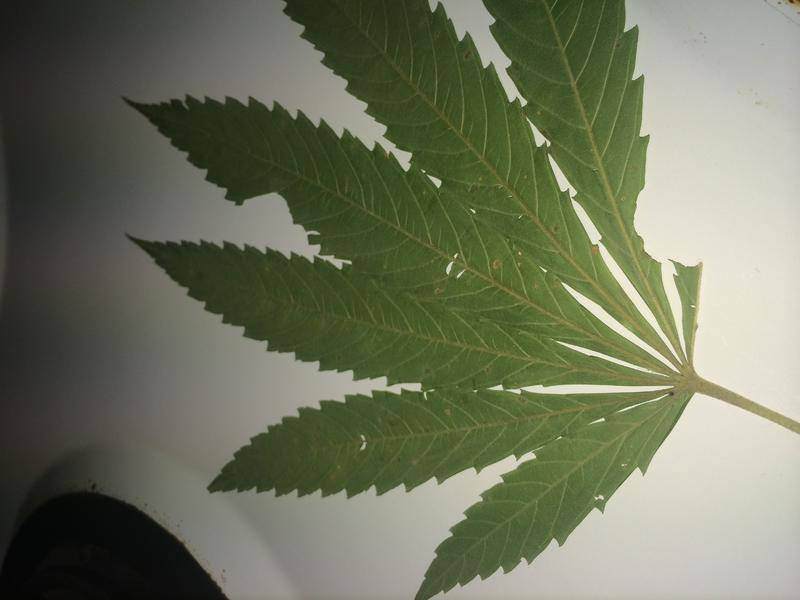
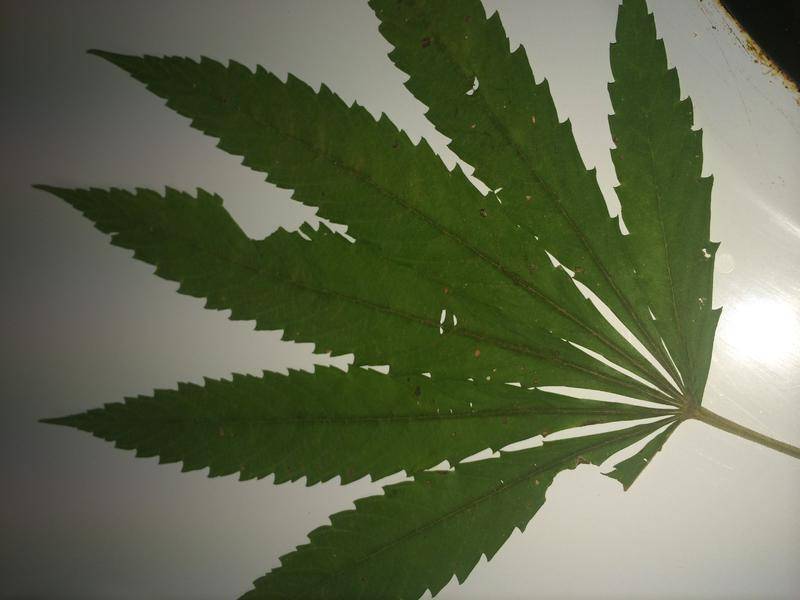
I pulled some leaves off and I took some photos of a few spots on the leaves. What do you all thing this is? Anything to be concerned about?
Kygiacomo!!!
AppAlachiAn OutLaW
I am a guerilla grower and when I was out at my plants a few days ago, I noticed some spots on the leaves. I did not know about leaf spot disease until i read up on it after i got home.
I pulled some leaves off and I took some photos of a few spots on the leaves. What do you all thing this is? Anything to be concerned about?
[URL=https://www.icmag.com/ic/picture.php?albumid=56636&pictureid=1322446&thumb=1]View Image[/url] [URL=https://www.icmag.com/ic/picture.php?albumid=56636&pictureid=1322445&thumb=1]View Image[/url] [URL=https://www.icmag.com/ic/picture.php?albumid=56636&pictureid=1322444&thumb=1]View Image[/url] [URL=https://www.icmag.com/ic/picture.php?albumid=56636&pictureid=1322443&thumb=1]View Image[/url] [URL=https://www.icmag.com/ic/picture.php?albumid=56636&pictureid=1322442&thumb=1]View Image[/url]
i know im a bit late to anwser but if u had leaf spot like the one hamsting posted about then u would know it..the plant will look raveged with brown looking leafs( not bud rot) just brownish with holes all in the leaves and extremely small yeilds if u can get anything at all.
It's very much environmental, not grower error. Do not deny your growing skills just because you've caught some spots fellas
snuggles
Active member
had this stuff too some years ago, was a wet summer....
what seemed to help was getting rid of the affected leaves, if possible.
and spraying with neem.
problem i had was that it was not possible to tend the gardens in a high frequency.
so it was just little damage control.
it is what it is... sometimes the odds are against you, even if you do your best.
keep on growing!
what seemed to help was getting rid of the affected leaves, if possible.
and spraying with neem.
problem i had was that it was not possible to tend the gardens in a high frequency.
so it was just little damage control.
it is what it is... sometimes the odds are against you, even if you do your best.
keep on growing!
Snuggles nailed it ^^^
Neem is a great preventative for all airborne fungal/bacterial diseases, as well as all-around plant health.
I just made a thread the other day regarding airborne pathogens and how to prevent them from ever happening - How to beat airborne pathogens
Neem is a great preventative for all airborne fungal/bacterial diseases, as well as all-around plant health.
I just made a thread the other day regarding airborne pathogens and how to prevent them from ever happening - How to beat airborne pathogens
Kygiacomo!!!
AppAlachiAn OutLaW
i wish i had took a pic of my holy grail kush of what a sever case of leaf spot will do..it took a 500 gram produceing strain down to around 14 grams of smokeable bud..it will not kill the plant or at least didnt in mine just reduces the yeild to nothing..the only thing that i seen to treat the problem was greencure..this year during spring when the leaf spot release the spores i will be ready for it bc im useing neem and karnaja oil to coat my leaves way before this shit ever takes hold so i wont need to treat a problem once it occurs hopefully..its alot easier to prevent the issue before it happens vs treating after being infected imo..
Cola Candy
Member
For indoor crops I use Plant Magic essence to treat LSF (leaf spot fungus i.e. the subject of this thread).
Here's the product blurb:
Essence is a highly concentrated bio-culture containing over 20 strains of micro organisms
to re-establish balanced bio-activity.*
Benefits of Essence
Once activated Essence produces a powerful blend of beneficial organisms that will quickly colonize the surface of leaves and stems to:-
* Form an effective barrier against airborne pathogenic fungi
* Combat existing fungal pathogens
* Improve disease and stress resistance
* Healthier, more robust growth
*The blend includes Bacillus strains such as B subtilis and B mageterium together with Rhizobia, Azotobacter (nitrogen fixers), Sacchoromyces, trichoderma and other natural strains. There are no pathogens or harmful organisms present.
This stuff needs to be sprayed every 5-7 days although when the plant is healthy once every 7 days is enough. You bubble it for 12 hours with molasses and then spray with a small amount of a wetting agent like yucca extract (Plant Magic also do this and it comes with the main essence starter kit). This is better than copper on crops you're going to consume. That said, despite the concerns in this thread, if you make sure not to spray buds, it won't end up in your buds in sufficient amounts to do any harm. Remember, our bodies need copper and small amounts are actually good for us, it's just when the amounts become toxic that it becomes a problem. So copper is a good solution for outdoor growers where few things work on this terrible disease and as long as it's used sensibly it will be safe.
Generally leaf coating fungicides are not good at controlling fungus once a plant is infected, the way they work is a barrier protective, ie they prevent air born spores germinating and infecting leaves. So you need to spray healthy leaves to keep them from getting infected and leaves already showing signs of infection cannot be treated.
Here's the product blurb:
Essence is a highly concentrated bio-culture containing over 20 strains of micro organisms
to re-establish balanced bio-activity.*
Benefits of Essence
Once activated Essence produces a powerful blend of beneficial organisms that will quickly colonize the surface of leaves and stems to:-
* Form an effective barrier against airborne pathogenic fungi
* Combat existing fungal pathogens
* Improve disease and stress resistance
* Healthier, more robust growth
*The blend includes Bacillus strains such as B subtilis and B mageterium together with Rhizobia, Azotobacter (nitrogen fixers), Sacchoromyces, trichoderma and other natural strains. There are no pathogens or harmful organisms present.
This stuff needs to be sprayed every 5-7 days although when the plant is healthy once every 7 days is enough. You bubble it for 12 hours with molasses and then spray with a small amount of a wetting agent like yucca extract (Plant Magic also do this and it comes with the main essence starter kit). This is better than copper on crops you're going to consume. That said, despite the concerns in this thread, if you make sure not to spray buds, it won't end up in your buds in sufficient amounts to do any harm. Remember, our bodies need copper and small amounts are actually good for us, it's just when the amounts become toxic that it becomes a problem. So copper is a good solution for outdoor growers where few things work on this terrible disease and as long as it's used sensibly it will be safe.
Generally leaf coating fungicides are not good at controlling fungus once a plant is infected, the way they work is a barrier protective, ie they prevent air born spores germinating and infecting leaves. So you need to spray healthy leaves to keep them from getting infected and leaves already showing signs of infection cannot be treated.
^ It sounds like some good old fashioned compost tea to me, any quality humus will give you those same benefits for a fraction of the cost of a fancy bottle.
Kygiacomo!!!
AppAlachiAn OutLaW
hey guys i found another potential prevention spray/drench to combat this shit. u guys can check it out,but im getting it this year and will let u know how it works out.
Advanced, Broad Spectrum Disease Control
REGALIA® is an advanced biofungicide that triggers a plant’s natural defenses to control a broad spectrum of agronomically important fungal and bacterial diseases. Active against both soilborne and foliar pathogens, REGALIA is proven to make protection programs better by improving pest control, enhancing plant growth, and increasing yield on a vast array of crops against a wide range of diseases. Featuring multi-site activity and complex mode of action, it delays the development of resistance and used in late-season application, it helps minimize chemical residues in harvested produce. Highly versatile and effective, REGALIA is an ideal product for broad spectrum disease control and fungicide resistance management programs.
Effective against a broad range of soilborne and foliar diseases…
REGALIA can be used alone, in rotation or in tank mix with most commercial fungicides to control a broad spectrum of bacterial and fungal diseases such as powdery mildew, downy mildew, Botrytis, bacterial spot and bacterial canker. What’s more, Regalia is effective against destructive soilborne pathogens including Pythium, Fusarium, Rhizoctonia and Phytopthora.
Complex mode of action enhances resistance management …
When treated with REGALIA, a plant’s defense system is ‘switched on’ to protect against attacking diseases. Research shows that plants treated with REGALIA produce, and accumulate, elevated levels of specialized proteins and other compounds known to inhibit fungal and bacterial diseases. REGALIA induces a plant to produce phytoalexins, cell strengtheners, antioxidants, phenolics, and PR proteins, which are all known inhibitors of plant pathogens.
http://www.marronebioinnovations.com/products/brand/regalia/
Advanced, Broad Spectrum Disease Control
REGALIA® is an advanced biofungicide that triggers a plant’s natural defenses to control a broad spectrum of agronomically important fungal and bacterial diseases. Active against both soilborne and foliar pathogens, REGALIA is proven to make protection programs better by improving pest control, enhancing plant growth, and increasing yield on a vast array of crops against a wide range of diseases. Featuring multi-site activity and complex mode of action, it delays the development of resistance and used in late-season application, it helps minimize chemical residues in harvested produce. Highly versatile and effective, REGALIA is an ideal product for broad spectrum disease control and fungicide resistance management programs.
Effective against a broad range of soilborne and foliar diseases…
REGALIA can be used alone, in rotation or in tank mix with most commercial fungicides to control a broad spectrum of bacterial and fungal diseases such as powdery mildew, downy mildew, Botrytis, bacterial spot and bacterial canker. What’s more, Regalia is effective against destructive soilborne pathogens including Pythium, Fusarium, Rhizoctonia and Phytopthora.
Complex mode of action enhances resistance management …
When treated with REGALIA, a plant’s defense system is ‘switched on’ to protect against attacking diseases. Research shows that plants treated with REGALIA produce, and accumulate, elevated levels of specialized proteins and other compounds known to inhibit fungal and bacterial diseases. REGALIA induces a plant to produce phytoalexins, cell strengtheners, antioxidants, phenolics, and PR proteins, which are all known inhibitors of plant pathogens.
http://www.marronebioinnovations.com/products/brand/regalia/
Cola Candy
Member
^ It sounds like some good old fashioned compost tea to me, any quality humus will give you those same benefits for a fraction of the cost of a fancy bottle.
No no, it is completely different! Compost tea is very hit and miss and inconsistent and you can't guarantee it will provide all of the fungi and bacteria in the product, such as trichoderma harzianum which is very important.
Here's a relevant post from Oltimer1 on ***** that you might want to read:
I Zimbra, on Aug 15 2008, 12:29 PM, said:
intersting, so what would you find in the essence that you wouldn't find in a good quality AACT?
Oldtimer1:
The essence inoculant contains several species of trichoderma and other protective bacteria, these have been selected for populating the ariel parts of the plant, ie the leaves branches and stem, it was first made to form a living barrier to protect against aerial plant infections. This selected blend of pure spore cultures are derived from naturally occurring beneficial species. While it is meant to be used to protect healthy plants against infection for organic farmers, we found that it also cures or halts leaf fungus infections when used on infected cannabis plants. To me this is much better than using systemic fungicides.
My grandfather made teas by steeping manure and compost in rain water and stirring vigorously several times a day, I used to have the job of drenching the plants as soon as I could carry a watering can, that was some sixty years ago, I have been using teas ever since, mind I don't follow the milk cart with a bucket and spade to collect the horses dropping every day anymore. To this day I don't grow as good fruit and veg as my grandfather did, but they are pretty good, I just don't put the time and effort into it that he did, thats my loss.
The thing about bubbled compost teas is they are better than grandfathers, in that they propagate and multiply all the aerobic bacteria and some fungi, this is good as these are mainly beneficial types but we have to remember there are some pathogens as well, [it depends on what is in the compost] it also passes on any anaerobic micro spoors in the compost, ie they will also get passed on in the spray or drench. The majority of micros are goodies though and mainly composed of species involved in the breakdown of carbon products + N and P miners.
These types do most good when used as a drench as it will contain the free NPK + all the secondaries released so far by the heard/breakdown process in a form ready to be used immediately by the plants, you can practically see the plants say thank you, there are unlikely to be many protective species, but the drench will supply the soil with a host of breakdown and nutrient miners to carry on their work in the root zone, so its a feed and help in continual release of locked nutrient.
Foliar spraying will as I said feed the plant directly through the leaves, as all the free nutrients are in a usable form, so plants love it, but it is of little use to a diseased plant as a curative, except in that it helps feed the plant, its true that well fed plants with good balance of nutrients will have more resistance to infections, but they are not immune, so it could well help prevent infections in the first place.
Every thing has its place, I hope this helps.
Last edited:
genedigger
Member
ive grown outdoors a bunch and i have gotten this on plants before.from what i found out its from leaf hoppers.there these pesky little jumping insects that can change color to fit in with surroundings and they carry so many diseases.get rid of the bugs and it may solve your problem.i worked at an organic veggie farm and i saw these leaf hoppers take out a whole potatoe crop from the disease they can spread.
Cola Candy
Member
One thing I would like to add, is if you choose to go down the route of using an actively aerated compost tea (AACT) then you should at least do it properly. Most of the recipes and techniques as well as the equipment used by most cannabis growers are wholly inadequate. Dr. Elaine Ingham is probably the single most influential leading scientist in her field and she runs the Soil Food Web website (you can Google it) as well as having written various books on the subject, one of which I have in my possession. The one I have is called 'The Compost Tea Brewing Manual' and is the 5th edition. I just searched it and it's now online as a pdf so you guys don't even have to buy it - The Compost Tea Brewing Manual PDF. God I wish the pdf had come out when I was looking to order it so I didn't have to buy it lol. Anyway it is all based on science and research rather than conjecture and anecdotes from gardeners and there are recipes towards the end of the book for different plant types that I would urge anyone to read as they will keep your plants healthy and vigorous even if they don't cure disease per se.
I would also be sure to buy or make a proper compost tea brewer rather than simply use a bucket and an airstone if at all possible. My 5 gallon compost tea brewer works by having a frame that suspends a plastic mesh bag with a zip about the size of a large pencil case that holds the compost and the bubbles come up and around the bag, permeating through the compost without the stuff floating everywhere so when it's done, you simply pour the tea out and empty and clean the pouch. There are lots of reasons why it is superior to the bucket and airstone method which I won't get into but the book goes does go into all of that.
I would also be sure to buy or make a proper compost tea brewer rather than simply use a bucket and an airstone if at all possible. My 5 gallon compost tea brewer works by having a frame that suspends a plastic mesh bag with a zip about the size of a large pencil case that holds the compost and the bubbles come up and around the bag, permeating through the compost without the stuff floating everywhere so when it's done, you simply pour the tea out and empty and clean the pouch. There are lots of reasons why it is superior to the bucket and airstone method which I won't get into but the book goes does go into all of that.
^ Very good points made here Cola Candy
I've learned the hard way one too many times about making my own mix, and unless you have a microscope you really don't know what is in that tea, it could be full of anaerobes that will mess up your entire system if applied.
Microbe Man's recipes can be found at www.microbeorganics.com
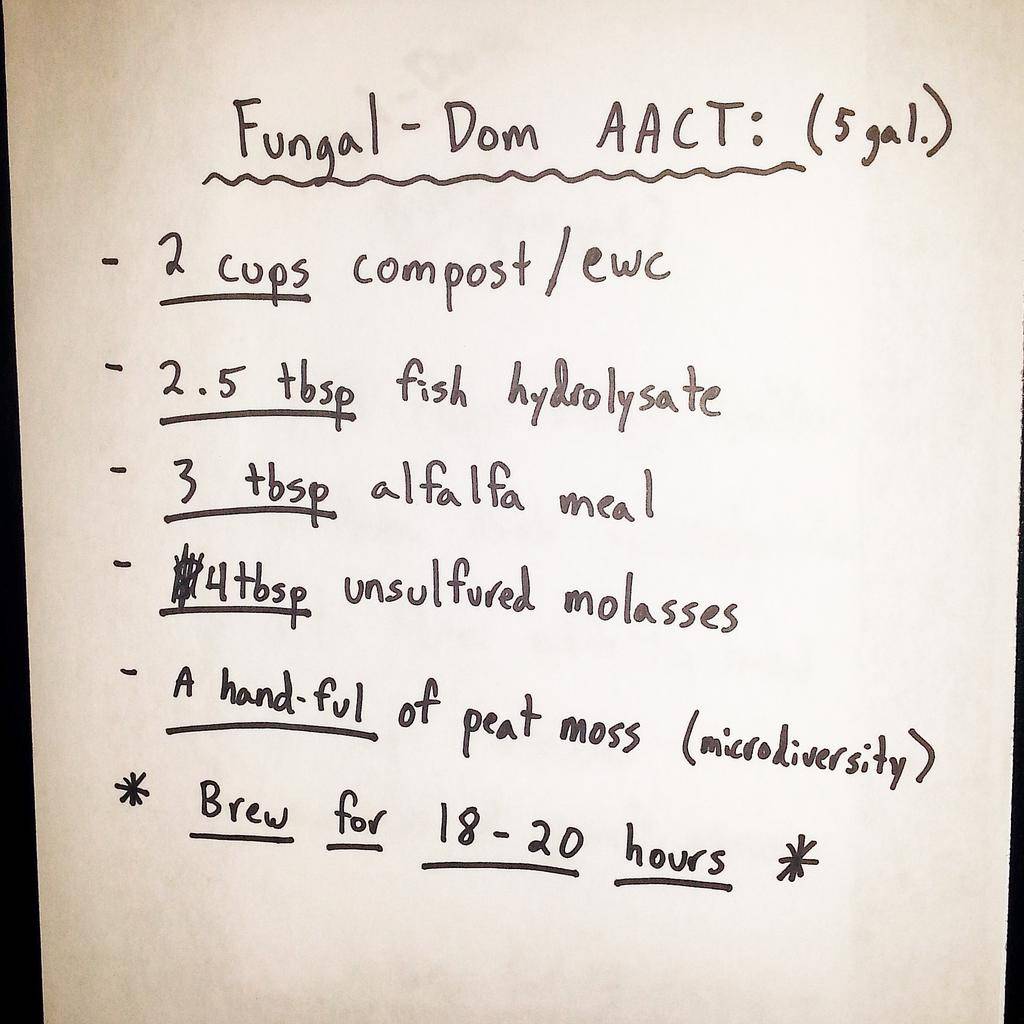
This is the fungal dominant brew I use, the nutrient cycling recipe that I usually use can be found at microbeorganics.com
I've learned the hard way one too many times about making my own mix, and unless you have a microscope you really don't know what is in that tea, it could be full of anaerobes that will mess up your entire system if applied.
Microbe Man's recipes can be found at www.microbeorganics.com
This is the fungal dominant brew I use, the nutrient cycling recipe that I usually use can be found at microbeorganics.com
Cola Candy
Member
Very interesting TM, I wasn't aware of his websites so thanks for sharing that.
I back Elaine 100% though, I'm sure her recipes are very similar since they both use scopes to analyze their teas. I saw a movie that featured her actually, it's really good: Symphony of the Soil. I highly recommend it if you haven't seen it yet!



